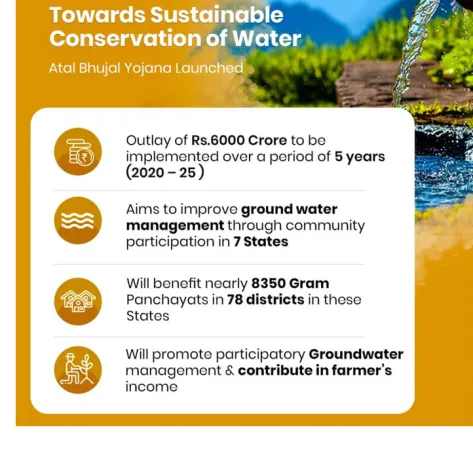ATAL BHUJAL YOJANA — WHY A SCHEME FOR GROUNDWATER
Context:
Prime Minister Narendra Modi launched Atal Bhujal Yojana on the occasion of 95th birth anniversary of former Prime Minister Atal Bihari Vajpayee. The Central Government has allocated Rs. 6000 crores for this scheme.
According to government, the Atal Bhujal Yojana has been brought to deal with the groundwater problem.
It will cost Rs 6000 crores rupees in 5 years. However Rs. 3000 crore will be given by World Bank and Rs 3000 crores to be spent by the government.
The Government has selected seven states for this scheme according to the level of groundwater exploitation in these areas.
The Government has also selected these areas due to their institutional readiness, degradation, established legal and regulatory instruments, and experience in implementing initiatives related to groundwater management.
How scarce is water in India?
- India accounts for 16-17% per cent of the world’s population living in less than 5 per cent of the global area, and has just 4 per cent of the global water resources.
- According to the Central Water Commission (CWC), the estimated water resources potential of the country, which occurs as natural runoff in the rivers, is 1,999 billion cubic metres.
- Of this, the estimated utilisable resources are 1,122 billion cubic metres per year 690 BCM per year surface water and 432 BCM per year replenishable groundwater.
- With the population rising, demand for water will increase manifold in coming years. According to the CWC, per capita availability in the country will decrease from 1,434 cubic metres in 2025 to 1,219 cubic metres in 2050.
- By CWC benchmarks, a water-stressed condition happens when per capita availability is less than 1,700 cubic metres, and a water-scarcity condition when per capita availability falls below 1,000 cubic metres. Some river basins are facing a water-scarcity condition.
- Among these are the basins of the Indus (up to the border), Krishna, Cauvery, Subarnarekha, Pennar, Mahi, Sabarmati and east-flowing rivers, and west-flowing rivers of Kutch and Saurashtra including Luni.
‘Water and Related Statistics 2019’ report:
According to ‘Water and Related Statistics 2019’, a report published by the CWC, the annual replenishable groundwater resources in India (2017) are 432 BCM, out of which 393 BCM is the annual “extractable” groundwater availability.
Fifteen states account for about 90 per cent of the groundwater potential in the country. Uttar Pradesh accounts for 16.2 per cent, followed by Madhya Pradesh (8.4%), Maharashtra (7.3%), Bihar (7.3%), West Bengal (6.8%), Assam (6.6%), Punjab (5.5%) and Gujarat (5.2%).
The current annual groundwater extraction is 249 BCM, the largest user being the irrigation sector. This is why the government has called for alternatives to water-intensive crops such as paddy and sugarcane.
Compared to the decadal average for 2009-18, there has been a decline in the groundwater level in 61% of wells monitored by the Central Ground Water Board (CGWB).
Among the states where at least 100 wells were monitored, the highest depletion has been in Karnataka (80%), Maharashtra (75%), Uttar Pradesh (73%), Andhra Pradesh (73%), Punjab (69%).
About Atal Bhujal Yojana:
This scheme has been launched with an aim to raise the groundwater level in those areas where it has significantly gone down.
The objective of the scheme is to increase the level of groundwater. Also, this scheme has been brought by the central government to provide benefits to the farmers.
The central government wants to ensure adequate water storage for farmers under this scheme.
It has formed to benefit seven states – Gujarat, Haryana, Karnataka, Madhya Pradesh, Maharashtra, Rajasthan and Uttar Pradesh with an aim to bring community-level groundwater management.
This scheme is expected to benefit about 8350 Gram Panchayats in 78 districts of these states.
Who Will Fund for the Atal Bhujal Yojana?
As per reports, out of the total outlay of Atal Bhujal Yojana, 50 percent will be in the form of a World Bank loan and be repaid by the Central Government.
The remaining 50 percent will be through Central Assistance from regular budgetary support. The entire World Bank’s loan component and Central Assistance will be passed on to the states as Grants.
Conclusion:
Water scarcity is most acute in the basins of the Cauvery, Pennar, Sabarmati and east-flowing rivers, and west-flowing rivers of Kutch and Saurashtra including Luni. The focus will be on arresting the rate of decline of groundwater levels as well as water consumption. The scheme will seek to strengthen the institutional framework and bring about behavioural changes at community level for sustainable groundwater resource management. It envisages community-led Water Security Plans. The Atal Jal Yojana to encourage Gram Panchayats to perform better in water management. In the last 70 years only 3 crore people have got the piped water supply facility out of 18 crore rural households. Now, the government has set a target to provide clean drinking water facility to 15 crore households in the next five years.


